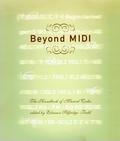Beyond MIDI: The Handbook of Musical Codes
|
 |
Beyond MIDI: The Handbook of Musical Codes
|
 |
|
The organization of MuseData files is an integral part of the MuseData representation. Each MuseData file represents the encoding of one musical part from a movement from a composition. In the following scheme one file would contain the information required for Part 1, Bars 1-11, another Part 2 (Bars 1-11), another Part 3 (Bars 1-11), and so forth.

The arrangement of parts into systems and subsystems and the layout of system breaks and page breaks is irrelevant to the encoding of MuseData. However, a musical part may be notated as one line or more of music. For example, if a movement has two oboe parts, Oboe I and Oboe II, these may be encoded as separate parts, or they may be combined on one staff and encoded as a single musical part, namely Oboes I & II (e.g., Parts 1 and 2 above). In the latter case, verbal cues and directions would be used to differentiate the two parts. In the MuseData system, they may be encoded both ways, since a score might call for both oboes on one staff, but the players might want to play from separate parts. Music on the grand staff may be encoded as one or two parts. If musical notation or symbols cross between the staves of the grand staff, then the music on the grand staff must be treated as one musical part. 1.1 File Relationships within the Database
Our database currently consists of more than 7,000 MuseData files. When complete, the database could exceed 100,000 files. We currently use a hierarchical directory tree structure to organize these files, which is briefly outlined below. In this outline, you must imagine real composer names for COMPOSER1, COMPOSER2; real source names for SOURCE1, SOURCE2; and real work titles for WORK1, WORK2. Stage-1 files contain data for pitch and duration only (i.e., note and rest records) and support sound applications. Stage-2 files contain a great deal of additional information to support printing and interpretive applications. Stage-1 files are all of the same type, while Stage-2 files may belong to one or more of the following data-file types:
1.2 Organization of Single FilesMuseData files consist of a set of time-ordered, variable length ASCII records. The order of the records is essential to the representation. Single MuseData files have four essential components header records, a musical attributes record, a series of regular note records, and an end-of-file marker. All records are organized as a series of 80-character columns. The first character in each record is called the control key, and this key determines the nature and function of the record. A. Header RecordsThe first 12 lines of a MuseData file contain general information about the entire file. The format and contents of the header records are as follows:
Additional header records may be used, but those shown above are always used or, if not pertinent to the file at hand, reserved. Files that are distributed contain copyright and other identifying information in Records 1-3. B. Group Memberships [Record 11]The concept of group membership for parts facilitates flexibility in the creation of diverse kinds of scores and parts and in other uses of the data. Record 11 contains a list of names, which are the application groups to which this file belongs. The group names can be anything the encoder wishes them to be. In our data files, we use names that have an obvious connection to their associated application: e.g., score, parts, sound, tracks, shortscore, data, etc. For each name listed in Record 11, there is a record that starts with that name and specifies the order or ranking in the group to which it belongs. The idea is that all files for a particular movement should be placed in the same directory. This way, a program designed to compile a score would simply check every file in the directory and identify for use those belonging to the group called score. The order in the group would determine the top-to-bottom order in the score. A program designed to compile MIDI sound files would identify for use those belonging to the group called sound. The same method would apply for other applications such as printing parts, printing short scores, and compiling track data for melodic and harmonic analysis. C. The Musical Attributes Record [$]A musical attributes record immediately follows the last header record. In the above example it would constitute Record 13. This record identifies such attributes, usually pertaining throughout the file, as key signatures, time signatures, clef signs, etc. Musical attribute records always begin with a dollar sign ($) in Column 1. Their format is as follows:
The record may contain one or more fields; fields are initiated by the field identifier and terminated by a blank. In the case of clefs and directives, the field identifier may contain a number, which is the staff (1 or 2 at the moment) to which the clef or directive belongs. The absence of a number indicates Staff 1.
Here is one example of a musical attributes record:
K:-2 Q:8 T:3/8 C:4 C2:22 D:Allegro ma non troppo
Explanations of the parameters for the less self-evident data types represented in this record follow.
|